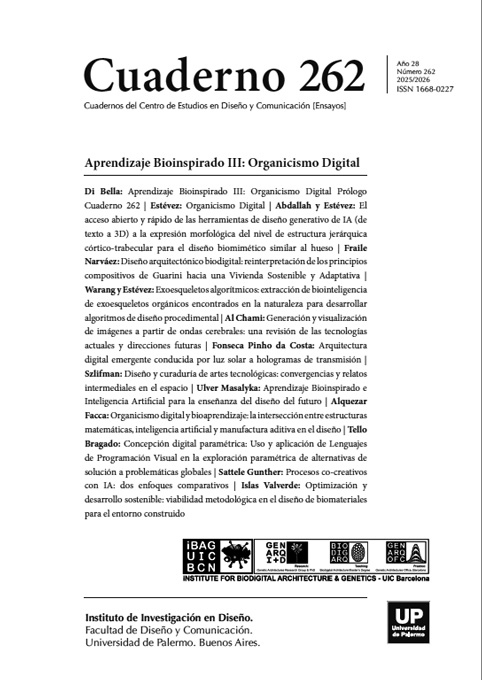Arquitectura digital emergente conducida por luz solar a hologramas de transmisión
Resumen
En este artículo se presenta un estudio sobre el uso de sistemas digitales emergentes en arquitectura a través de la computación, condicionado por parámetros ambientales relacionados con el contexto y buscando alcanzar un objetivo específico.
Citas
Bolte, M., Gardette, J.L., Müller, H.F.O., Knabben, L., Bahaj, A.S., James, P., Geith, A., Römhild, T., Jentsch, M., Ötes, A., & Topp, T. (2004). Holographic Optical Elements (HOE) for High Efficiency Illumination, Solar Control and Photovoltaic Power in Buildings. Umwelt-Campus Birkenfeld Entwicklungs- und Management GmbH, Birkenfeld.
Caldas, L.G. (2001). An Evolution-Based Generative Design System: Using Adaptation to Shape Architectural Form. MIT, Massachusetts Institute of Technology.
Chalmers, D. J. (2006). Strong and Weak Emergence. The Re-Emergence of Emergence - The Emergentist Hypothesis, 244–254
Estévez, A.T. (2021). Biodigital Architecture and Genetics II. iBAG - UIC Barcelona.
Gramazio, F., & Kohler, M. (2008). Digital Materiality in Architecture. Lars Muller Publishers.
Kolarevic, B., & Malkawi, A.M. (eds.). (2005). Performative Architecture - Beyond Instrumentality. Spon Press.
Marble, S. (2012). Digital Workflows in Architecture, Design-Assemble-Industry. Birkhauser.
Menges, A. (2007a). Computational Morphogenesis: Integral Form Generation and Materialization Processes. https://www.researchgate.net/publication/30873036
Simon, H.A. (1996). The Sciences of the Artificial (3ª ed.). MIT Press.
Sousa, J.P. (2020). Calculated Geometries. Experiments in Architectural Education and Research. Thinking, Drawing, Modelling, 131–143.
Thompson, D. W. (1945). On Growth and Form. The Macmillan Company.
Weinstock, M. (2010). The Architecture of Emergence: The Evolution of Form in Nature and Civilisation. Wiley.
Los autores/as que publiquen en esta revista ceden los derechos de autor y de publicación a "Cuadernos del Centro de Estudios de Diseño y Comunicación", Aceptando el registro de su trabajo bajo una licencia de atribución de Creative Commons, que permite a terceros utilizar lo publicado siempre que de el crédito pertinente a los autores y a esta revista.


